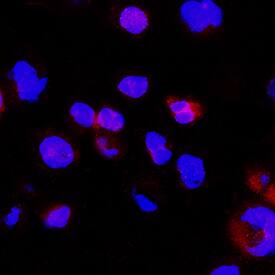Human LIGHT/TNFSF14 Antibody
R&D Systems, part of Bio-Techne | Catalog # MAB6641


Key Product Details
Species Reactivity
Applications
Label
Antibody Source
Product Specifications
Immunogen
Asp74-Val240
Accession # O43557
Specificity
Clonality
Host
Isotype
Scientific Data Images for Human LIGHT/TNFSF14 Antibody
LIGHT/TNFSF14 in HDLM‑2 Human Cell Line.
LIGHT/TNFSF14 was detected in immersion fixed HDLM-2 human Hodgkin's lymphoma cell line using Mouse Anti-Human LIGHT/TNFSF14 Monoclonal Antibody (Catalog # MAB6641) at 8 µg/mL for 3 hours at room temperature. Cells were stained using the NorthernLights™ 557-conjugated Anti-Rabbit IgG Secondary Antibody (red; Catalog # NL004) and counterstained with DAPI (blue). Specific staining was localized to cytoplasm. View our protocol for Fluorescent ICC Staining of Non-adherent Cells.Applications for Human LIGHT/TNFSF14 Antibody
Immunocytochemistry
Sample: Immersion fixed HDLM-2 human Hodgkin's lymphoma cell line
Formulation, Preparation, and Storage
Purification
Reconstitution
Formulation
Shipping
Stability & Storage
- 12 months from date of receipt, -20 to -70 °C as supplied.
- 1 month, 2 to 8 °C under sterile conditions after reconstitution.
- 6 months, -20 to -70 °C under sterile conditions after reconstitution.
Background: LIGHT/TNFSF14
Human LIGHT, also known as TNFSF14, is a type II membrane protein that is a member of the TNF superfamily. LIGHT is an acronym which stands for "is homologous to lymphotoxins, exhibits inducible expression, and competes with HSV glycoprotein D for HVEM, a receptor expressed by T lymphocytes". LIGHT has also been called HVEM-L and LT-gamma. LIGHT is a 240 amino acid (aa) protein that contains a 37 aa cytoplasmic domain, a 22 aa transmembrane region, and a 181 aa extracellular domain. Similar to other TNF ligand family members, LIGHT is predicted to assemble as a homotrimer. LIGHT is produced by activated T cells and was first identified by its ability to compete with HSV glycoprotein D for HVEM binding. LIGHT has also been shown to bind to the lymphotoxin beta receptor (LT betaR) and the decoy receptor (DcR3/TR6). LIGHT overexpression in tumor cells induces apoptosis, which can be enhanced by IFN-gamma.
References
- Mauri, D.N. et al. (1998) Immunity 8:21.
- Zhai, Y. et al. (1998) J. Clin. Invest. 102:1142.
- Harrop, J.A. et al. (1998) J. Biol. Chem. 273:27548.
- Yu, K-Y. et al. (1999) J. Biol. Chem. 274:13733.
Long Name
Alternate Names
Gene Symbol
UniProt
Additional LIGHT/TNFSF14 Products
Product Documents for Human LIGHT/TNFSF14 Antibody
Product Specific Notices for Human LIGHT/TNFSF14 Antibody
For research use only